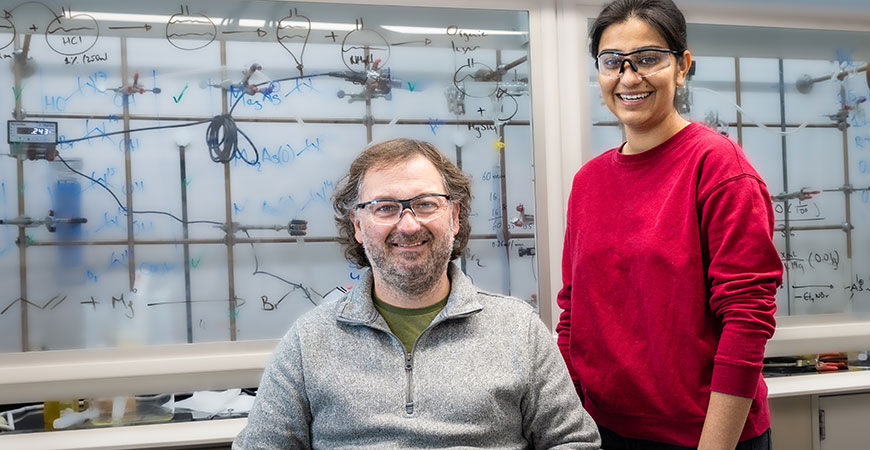
Carbon dioxide (CO2) is a greenhouse gas that is contributing to irreversible climate change. Scientists know how to capture CO2, and they know how to transform it into useful molecules and materials.
But that transformation is neither energy nor cost-effective.
Through a prestigious grant from the Department of Energy (DOE), a diverse group of scientists, including a chemist from UC Merced, plan to address that problem by coupling two chemistries which are known to work independently, but don't work well together.
Led by a professor at UC Irvine, Department of Chemistry and Biochemistry Professor Michael Findlater is part of the group that has formed a new DOE Energy Frontier Research Center (EFRC). This is the first time any researcher from UC Merced has been part of an EFRC, the DOE said.
“Chemists can take pure CO2 from cylinders and convert it, but that's not how CO2 exists,” Findlater said. “We generate it in these nasty, polluted air streams with these other contaminants from factories. The cement industry is one of the biggest CO2 producers. We know how to suck up these gases selectively and we can get clean CO2 from these streams.”
Direct air capture uses sorbents, substances that can collect the molecules of other substances, to grab the CO2. It's an expensive process, Findlater said, but it works even though it isn’t currently scalable. To convert the CO2, it must first be removed from the sorbent material.
“It turns out, 90% of the cost and 75% of the energy usage comes from just getting the CO2 back out of the sorbent,” Findlater said. “The way that we're approaching this is: Can we develop chemistry that simultaneously captures the CO2 on the sorbent and converts it while it's still stuck to the sorbent?”
The Center for Closing the Carbon Cycle calls this “Reactive Capture of CO 2,” and plans to advance the understanding of sorbents and catalysts so they can be co-designed to work cooperatively to achieve more active, efficient and durable systems for reactive capture, turning the CO 2 into materials such as fuels and industrial chemicals.
"The Chemistry and Biochemistry Department is excited about the innovative work coming out of the Findlater group regarding CO2 capture,” said Professor Ryan Baxter, department chair. “Current industrial processes are inefficient, and the Findlater group is using their expertise in organometallic chemistry to design new materials capable of turning a two-step process into a single step. Their work has the potential to impact CO2 emissions on a very large scale and the Department is proud to have Professor Findlater represent UC Merced in this collaborative effort."
The center will harness the strengths of researchers from UCs Merced, Irvine, Davis and Los Angeles; California State Polytechnic University, Pomona; California Institute of Technology; Case Western Reserve University; Elizabeth City State University; Lawrence Livermore, Oak Ridge and Pacific Northwest national laboratories; the University of Central Arkansas; the University of Colorado, Boulder; the University of Louisville; and the University of Michigan.
The Center for Closing the Carbon Cycle received a $10.3 million grant and is just one of 43 EFRCs established this year as part of $540 million in awards for sustainable energy technology and low-carbon manufacturing research at 54 universities and 11 national laboratories around the United States.
Many of the researchers participating in the new center are electrochemists and spectroscopists with a lot of experience and knowledge about instrumentation to look at chemical reactions. But Findlater’s lab is responsible for much of the molecular synthesis — making the things the center will study.
“We make a lot of metal-based catalysts,” he said, “so we'll be making the catalysts that drive this chemistry, that convert the CO2 into those valuable products. We’ll be sharing the catalysts with the electrochemists but one of our ultimate goals is to learn how to do electrochemistry ourselves, at least at a basic level so we can do a lot of the quick checks to make sure everything's working.”
Part of the center funding will be dedicated to sending students and postdoctoral researchers to the partner institutions to learn in their labs. Both undergraduate and graduate students will be involved in the research and get learning opportunities at the other universities in the summers.
Findlater also just received a $280,000 grant from the National Science Foundation and $120,000 in matching funds from UC Merced to purchase a new single crystal X-ray diffractometer that will come in handy with the EFRC research. He and his students will use the instrument to see molecular structures using high-energy X-ray technology.
“The X-rays interact with electrons, and you generate a pattern,” he said. “If you have a good crystal and you get a good data set, you can figure out the structure in an hour.”
Lorena Anderson

Senior Writer and Public Information Representative
Office: (209) 228-4406
Mobile: (209) 201-6255






